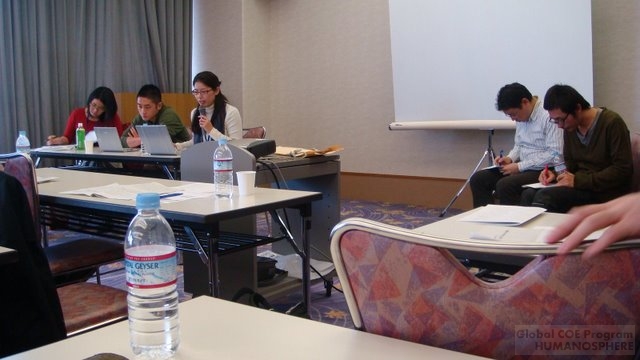"Rearrangement of "Area/ Society" for Sustainable Humanosphere"[Initiative 4 & Junior Researchers Joint Seminar](Junior Researchers Seminar)
Date: January 23-25, 2009
Venue: KKR Hotel Biwako
This symposium was attended by some 40 junior researchers specialized mainly in anthropology and area studies, and in five sessions over the three-day period, a total of ten research reports were presented. Intensive discussions were held aiming at a new style of research, one capable of coping with regional/social changes in contemporary society. Through discussions at these sessions and at the fellowship banquet, it became clear that the researchers at the gathering, specialized in diverse geographical regions and themes, face common circumstances and challenges, captured under the heading of “the contemporary.”
In Session 1, held on the first day and titled “Market-Oriented Economic Reform and Spatial Reorganization,” Yu Nishigaki noted that in the Ulan Bator City of Mongol, where rapid market-oriented economic reforms were introduced, public space was reproduced through interactions between the formation of the yurt district of nomads and the activities of NGOs stationed there. Naomi Hosoda followed, touching upon the relation between people’s experience of migration from rural areas into urban areas and changes in the world of magic in the Philippines. In the debate session, discussions centered on a contemporary situation in which market-oriented economic reforms have brought about a new social space.
In Session 2, entitled “Subsistence-supporting Livelihood and Ecological Dynamics,” held on the second day of the symposium, Miyo Nagakura took as research subject a mountain people in Lesotho, presenting empirical evidence on the relation between social change before and after the migrant labor boom, and way that this people took advantage of altitude differences in its use of land. Reiji Suzuki highlighted long-term changes in Myanmar’s forest vegetation resulting from the burn agriculture of local farmers and the influence of government policy in recent years. Following these two reports, debates took place on how dynamics of the ecology should be positioned with respect to their relation to political circumstances.
In Session 3, entitled “Dynamism of Religions and Changes in Local Community,” Hisashi Ogawa pointed to the friction and conflict introduced into local communities by the Thai Islamic Revival Movement, and Akimitsu Ikeda followed with a presentation of his views on the categories of religions and religious sects in the context of the Lebanese civil war.
In Session 4, entitled “Humanosphere Base in the midst of Conflicts,” Toru Sagawa argued that alternation between the two modes of battle and hospitality among the Ethiopian pastoral people emerged between the collectivity of warfare and social relations among individuals. Tadayuki Kubo delivered an interesting argument about the reality of various assistance activities carried out in Burmese refugee camps and the situation of multiple confrontational identities.
In Session 5, entitled “State Welfare Policy and the Living World” and held on the last day of the symposium, Teruhiro Yamakita presented arguments on the possibility of communities in Japan embracing the homeless through local community “welfare.” Makoto Kurata showed that the structuring process for health and medical services in Samoa evolved through interaction between the settlers, state administration and indigenous people.
At the general discussion session held in the afternoon of the final day, participants debated the question of how researchers should overcome ethical value confrontations with local communities given the contemporary situation faced by area studies, and also discussed how to go about linking success in this area to actual practice.
In addition to the eight working papers that emerged out of discussions at this symposium, a network of junior researchers, based mainly in the Kansai district, also came together through the meeting. With all these successes, the symposium turned out to be a very fruitful event indeed.
(Keichiro Matsumura, Shuhei Kimura)
